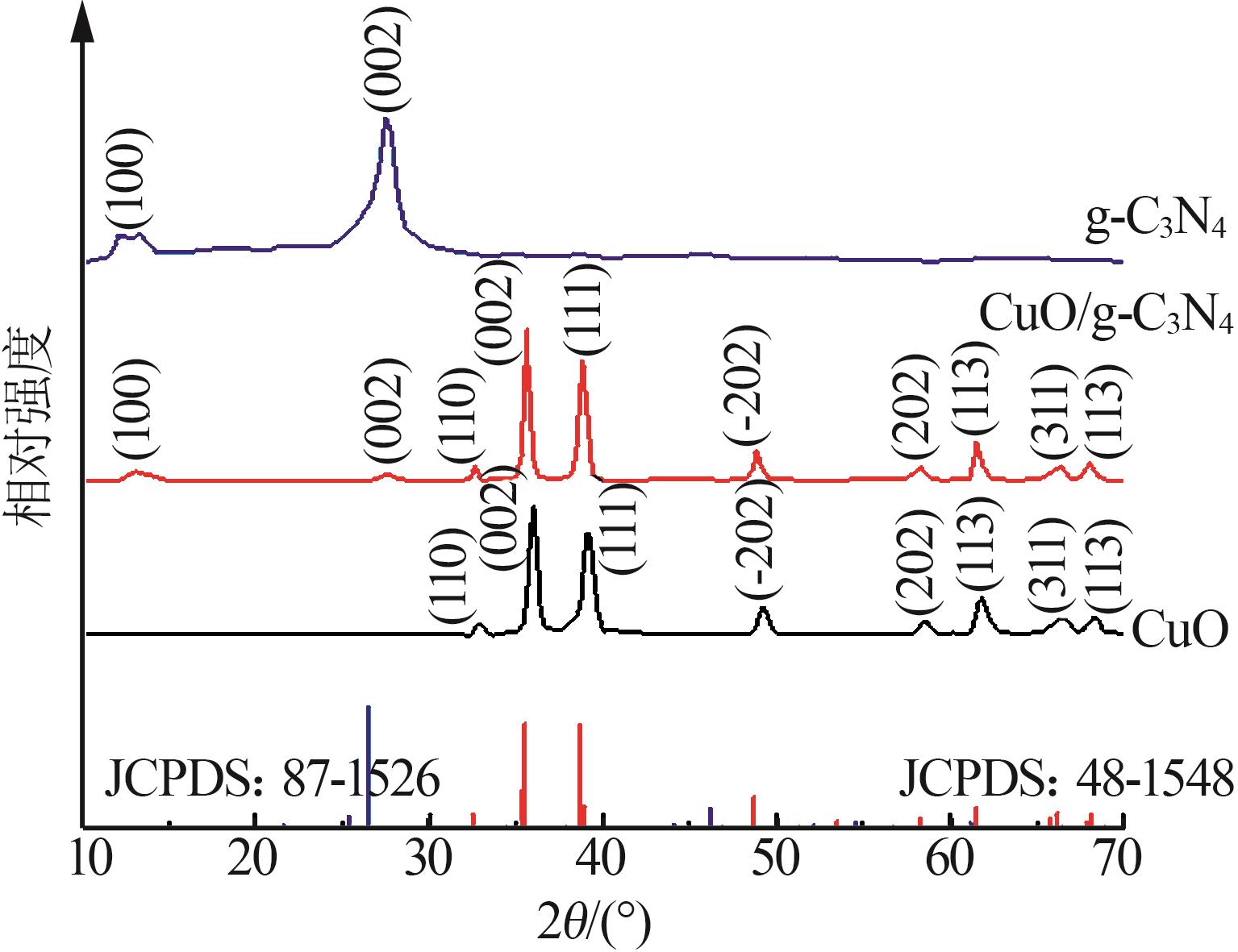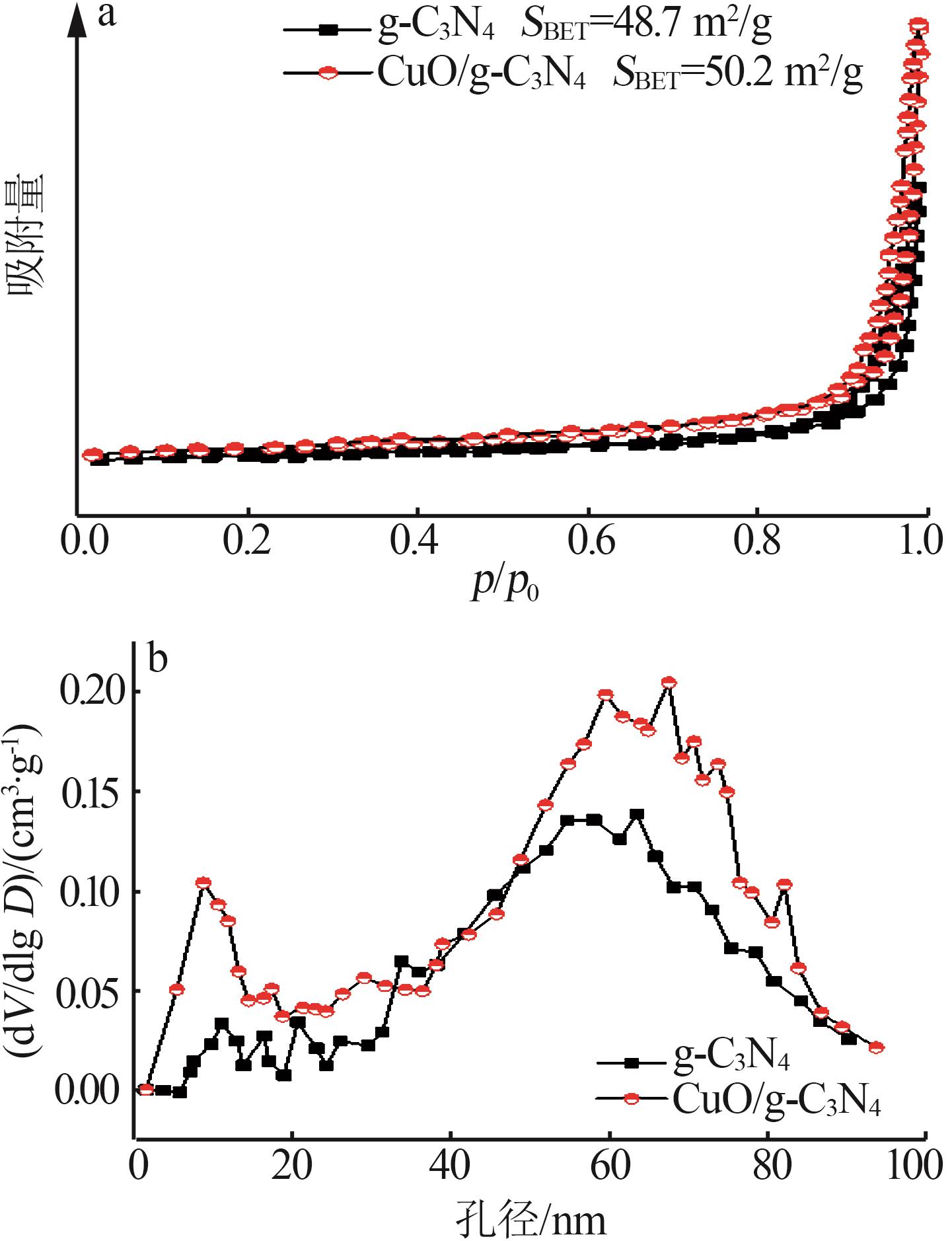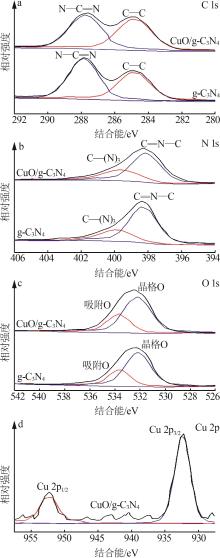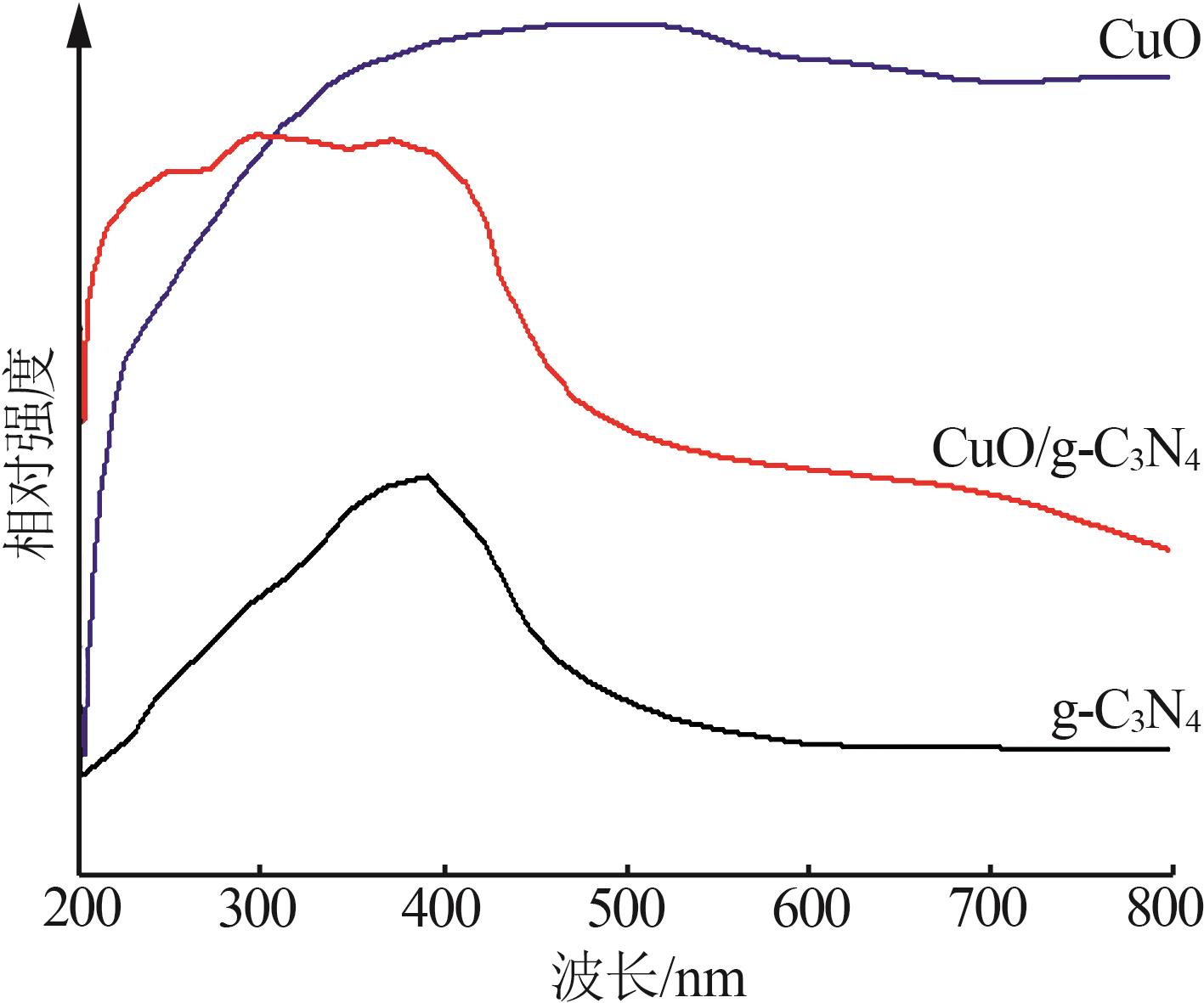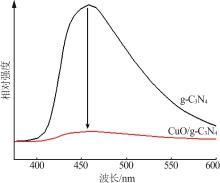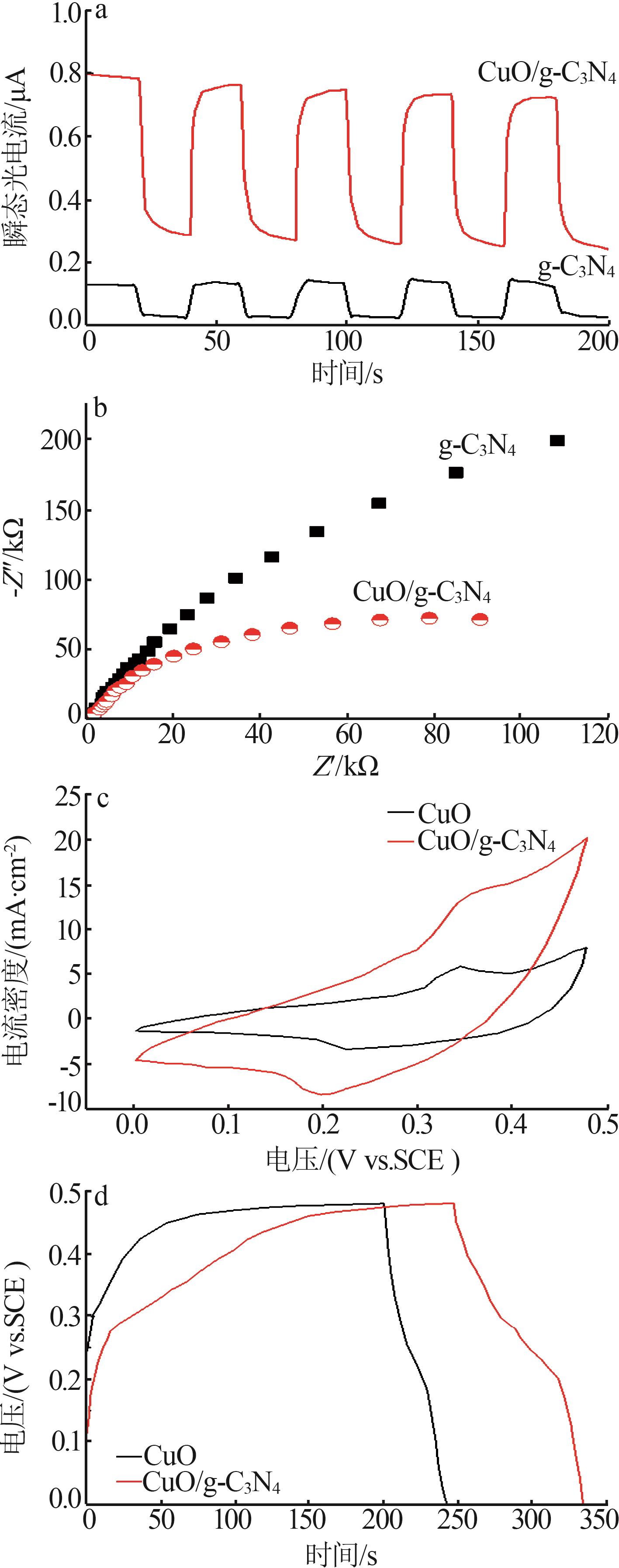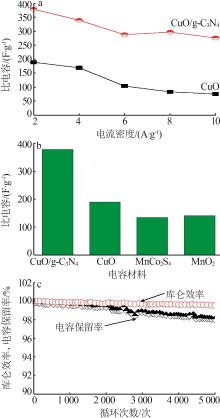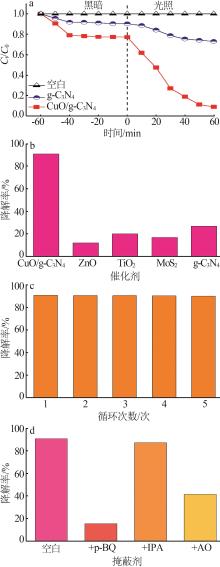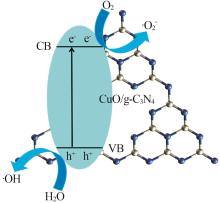Inorganic Chemicals Industry ›› 2025, Vol. 57 ›› Issue (1): 129-136.doi: 10.19964/j.issn.1006-4990.2024-0210
• O2-、h+、·OH。 • Previous Articles
Study on application of CuO/g-C3N4 composites in organic dye degradation and supercapacitors
ZHANG Feigang1( ), LIU Zhongli2
), LIU Zhongli2
- 1.Luoyang Vocational College of Culture and Tourist,Luoyang 471000,China
2.Harbin Institute of Technology,Harbin 150090,China
-
Received:2024-04-12Online:2025-01-10Published:2025-01-24
CLC Number:
Cite this article
ZHANG Feigang, LIU Zhongli. Study on application of CuO/g-C3N4 composites in organic dye degradation and supercapacitors[J]. Inorganic Chemicals Industry, 2025, 57(1): 129-136.
share this article
| 1 | 卜义夫,刘思乐,杜文娟,等.二硫化钼/石墨相氮化碳光催化降解印染废水研究[J].皮革科学与工程,2023,33(3):12-18. |
| BU Yifu, LIU Sile, DU Wenjuan,et al.Study on photocatalytic degradation of printing and dyeing wastewater by molybdenum disulfide/graphite carbon nitride[J].Leather Science and Engineering,2023,33(3):12-18. | |
| 2 | LIU Yucheng, LIAO Maoqi, GAN Dong,et al.Photocatalytic RGO membrane with carbon nitride nanotube intercalation for enhanced wastewater purification[J].Colloids and Surfaces A:Physicochemical and Engineering Aspects,2023,663:131080. |
| 3 | YANG Ke, ZHONG Shan, ZHOU Xuemei,et al.Controllable Al2O3 coating makes TiO2 photocatalysts active under visible light by pulsed chemical vapor deposition[J].Chemical Engineering Science,2023,277:118792. |
| 4 | XIONG Ya, LIU Teng, LIU Wendi,et al.1T-phase MoS2/holey ultrathin g-C3N4 nanosheets based 2D/2D heterostructure for enhanced photocatalytic hydrogen production[J].International Journal of Hydrogen Energy,2023,48(20):7284-7293. |
| 5 | 李春庚,甄新,李亚丽,等.印染废水染料降解技术研究进展[J].应用化工,2022,51(5):1439-1444. |
| LI Chungeng, ZHEN Xin, LI Yali,et al.Advances in dye degradation technology of printing and dyeing wastewater[J].Applied Chemical Industry,2022,51(5):1439-1444. | |
| 6 | 孙策,任巧琳,李青青,等.电絮凝处理模拟铬黑T染料废水[J].水处理技术,2024,50(1):85-89. |
| SUN Ce, REN Qiaolin, LI Qingqing,et al.Treatment of simulated eriochrome black T dye wastewater by electrocoagulation[J].Technology of Water Treatment,2024,50(1):85-89. | |
| 7 | 唐祝兴,余孟,张岐龙.MIL-101(Fe)光催化材料的制备及性能研究[J].电镀与精饰,2020,42(5):19-24. |
| TANG Zhuxing, YU Meng, ZHANG Qilong.Preparation and properties of MIL-101(Fe)photocatalytic materials[J].Plating & Finishing,2020,42(5):19-24. | |
| 8 | CHEN Xiaoxue, YU Fengqiu, GONG Fuzhong,et al.Preparation of 3D porous CeO2/g-C3N4 photocatalyst via facile one-step calcination for rapid removing of tetracycline[J].Vacuum,2023,213:112090. |
| 9 | WANG Jingquan, ZHANG Weijun, WU Huan,et al.Hydrothermal supramolecular preorganization synthesis of multi-morphological g-C3N4/Fe2O3 for photocatalytic removal of indoor formaldehyde under visible light[J].Journal of Environmental Chemical Engineering,2023,11(2):109395. |
| 10 | DOU Kai, PENG Chunyi, WANG Rongchen,et al.S-scheme tubular g-C3N4/BiOI heterojunctions for boosting photodegradation of tetracycline and Cr(Ⅵ):Mechanism insight,degradation pathway and DFT calculation[J].Chemical Engineering Journal,2023, 455:140813. |
| 11 | WANG Lijuan, LI Yinghan, CAI Jun,et al.Construction of Z-scheme ZnO/g-C3N4 photocatalytic systems for degradation of dyeing wastewater[J].Materials Today Communications,2024,39:109055. |
| 12 | 韩碧波,刘世凯,宋志健,等.Bi2WO6/g-C3N4复合光催化剂的制备及其光催化性能研究[J].现代化工,2024,44(4):175- 179. |
| HAN Bibo, LIU Shikai, SONG Zhijian,et al.Preparation of Bi2WO6/g-C3N4 composite photocatalyst and its photocatalytic property[J].Modern Chemical Industry,2024,44(4):175-179. | |
| 13 | 赵文璞,赵晓东,季惠明,等.SiO2/g-C3N4复合材料的3D打印制备及对染料废水的处理性能[J].工业水处理,2024,44(3):64-73. |
| ZHAO Wenpu, ZHAO Xiaodong, JI Huiming,et al.Preparation of SiO2/g-C3N4 composite material by 3D printing and its treatment properties for wastewater containing dyes[J].Industrial Water Treatment,2024,44(3):64-73. | |
| 14 | 张勇,薛顺昌,杨净,等.CoAl-LDHs基超级电容器电极材料研究进展[J].功能材料,2021,52(10):10083-10091. |
| ZHANG Yong, XUE Shunchang, YANG Jing,et al.Research progress of CoAl-LDHs supercapacitor electrode materials[J].Journal of Functional Materials,2021,52(10):10083-10091. | |
| 15 | 张永霞,王玫,方华,等.Co3O4/碳纳米管复合膜的超级电容器性能[J].电镀与精饰,2020,42(2):1-4. |
| ZHANG Yongxia, WANG Mei, FANG Hua,et al.Co3O4/carbon nanotube composite film for supercapacitor and its performanc-es[J].Plating & Finishing,2020,42(2):1-4. | |
| 16 | 苏展,于金山,裴锋,等.溶剂热法制备形貌可控的NiCo2O4超电材料及其性能研究[J].电镀与精饰,2021,43(12):1-6. |
| SU Zhan, YU Jinshan, PEI Feng,et al.Preparation of NiCo2O4 supercapacitor electrode materials with controllable morphology by solvent-thermal method and research of their properties[J].Plating and Finishing,2021,43(12):1-6. | |
| 17 | 李嘉欣,钟雯诗,刘召妹,等.低成本硫掺杂多孔碳材料的制备及其超级电容性能[J].无机化学学报,2024,40(2):325- 335. |
| LI Jiaxin, ZHONG Wenshi, LIU Zhaomei,et al.Preparation of low-cost S-doped porous carbons for high-performance supercapacitors[J].Chinese Journal of Inorganic Chemistry,2024,40(2):325-335. | |
| 18 | 汤继俊,高贵成.金属有机骨架材料的超级电容性能研究[J].江苏科技大学学报(自然科学版),2023,37(5):44-51. |
| TANG Jijun, GAO Guicheng.Study on the properties of supercapacitors of organometallic framework materials[J].Journal of Jiangsu University of Science and Technology(Natural Science Edition),2023,37(5):44-51. | |
| 19 | 史磊,费明婕,陈奇志,等.MnFe2O4/graphene的制备及其超级电容性能[J].中国陶瓷,2023,59(8):10-14. |
| SHI Lei, FEI Mingjie, CHEN Qizhi,et al.Preparation and supercapacitive performance of MnFe2O4/graphene[J].China Ceramics,2023,59(8):10-14. | |
| 20 | 巩鹏妮,弓巧娟,梁云霞,等.镍钴硫化物、石墨烯与聚苯胺复合材料在超级电容器中的应用研究进展[J].电镀与精饰,2023,45(3):90-94. |
| GONG Pengni, GONG Qiaojuan, LIANG Yunxia,et al.Research progress of Ni-Co sulfide,graphene and polyaniline composites applied in supercapacitors[J].Plating & Finishing,2023,45(3):90-94. | |
| 21 | 赵玉娜,陈锋,周军双,等.石墨烯/PEDOT:PSS复合纤维的制备及超级电容性能[J].燕山大学学报,2023,47(2):106-111. |
| ZHAO Yuna, CHEN Feng, ZHOU Junshuang,et al.Preparation of graphene/PEDOT:PSS composite fiber and its supercapacitor properties[J].Journal of Yanshan University,2023,47(2):106-111. | |
| 22 | 吴童,古庆玉,王培鉴,等.CoO@CuO电极材料制备及超级电容性能研究[J].硅酸盐通报,2021,40(1):317-322. |
| WU Tong, GU Qingyu, WANG Peijian,et al.Preparation and supercapacitor performance of CoO@CuO electrode materials[J].Bulletin of the Chinese Ceramic Society,2021,40(1):317-322. | |
| 23 | DAI Lei, SUN Fazhe, FU Peng,et al.Enhanced photocatalytic hydrogen evolution and ammonia sensitivity of double-heterojunction g-C3N4/TiO2/CuO[J].RSC Advances,2022,12(21):13381-13392. |
| 24 | BASELY A M, SHAKER M H, HELMY F M,et al.Construction of Bi2S3/g-C3N4 step S-scheme heterojunctions for photothermal decomposition of rhodamine B dye under natural sunlight radiations[J].Inorganic Chemistry Communications,2023,148:110300. |
| 25 | CHEN Miaogen, CHANG Wenya, ZHANG Jing,et al.Preparation of a hybrid TiO2 and 1T/2H-MoS2 photocatalyst for the degradation of tetracycline hydrochloride[J].ACS Omega,2023,8(17):15458-15466. |
| 26 | 刘思乐,卜义夫,陶洋,等.g-C3N4掺杂TiO2/活性炭复合光催化剂的制备及其光催化性能[J].印染,2022,48(3):16-20. |
| LIU Sile, BU Yifu, TAO Yang,et al.Preparation and photocatalytic performance of g-C3N4 doped TiO2/activated carbon composite photocatalyst[J].China Dyeing & Finishing,2022,48(3):16-20. | |
| 27 | 唐贝.ZnO/g-C3N4异质结光催化材料的制备及对吡啶的降解[J].无机盐工业,2024,56(4):133-142. |
| TANG Bei.Preparation of ZnO/g-C3N4 heterojunction photocatalytic material and its degradation of pyridine[J].Inorganic Che-Industry micals,2024,56(4):133-142. | |
| 28 | CHEN Xiyu, WU Fangzhou, HAN Jun,et al.Enhanced photocatalytic degradation of tetracycline hydrochloride over Cd-CdS@g-C 3N4under visible light irradiation[J].Materials Today Communications,2024,39:108496. |
| [1] | WANG Ping, XU Rongsheng, SUN Dong, SHI Xiaohong, XU Wei, LI Mei. Study on preparation of nitrogen-doped biochar and its adsorption properties for methylene blue [J]. Inorganic Chemicals Industry, 2024, 56(9): 117-127. |
| [2] | ZHANG Bangcheng, WANG Li. Preparation and adsorption properties of waste polyester⁃based activated carbon activated by ZnCl2 [J]. Inorganic Chemicals Industry, 2024, 56(7): 126-134. |
| [3] | WANG Yawen, WANG Fangfang, GENG Siyu, JU Jia, CHEN Lei, CHEN Changdong. Study on preparation and photocatalytic performance of SrTiO3-SrWO4 [J]. Inorganic Chemicals Industry, 2024, 56(7): 143-149. |
| [4] | LIU Min, HUANG Xiu, ZHANG Liyuan. Research progress of S-type heterojunction photocatalysts [J]. Inorganic Chemicals Industry, 2024, 56(7): 18-27. |
| [5] | WU Qingqing, XU Xuetang, WANG Fan. Study on capacitor performance of high⁃mass⁃loading ZnCo-based carbonate hydroxide electrode materials [J]. Inorganic Chemicals Industry, 2024, 56(7): 46-54. |
| [6] | TANG Bei. Preparation of ZnO/g-C3N4 heterojunction photocatalytic material and its degradation of pyridine [J]. Inorganic Chemicals Industry, 2024, 56(4): 133-142. |
| [7] | ZHOU Xuan, LI Mengrui, CHEN Yichen, FAN Huiqiang, WANG Bin, YUAN Gang. Research progress of nickel-based phosphide composites in improving of catalytic water electrolysis for hydrogen evolution performance [J]. Inorganic Chemicals Industry, 2024, 56(4): 8-15. |
| [8] | LI Qiaoyun, HUANG Xiuxing, WEI Wenye, CHEN Zhen. Study on adsorption of methylene blue by activated carbon with acid/alkali synergistically modified fly ash [J]. Inorganic Chemicals Industry, 2024, 56(3): 131-136. |
| [9] | HUANG Jianan, LU Xiaoyu, WANG Mitang. Effect of Ba-La co-doping on degradation of methylene blue dye by TaON [J]. Inorganic Chemicals Industry, 2024, 56(2): 146-151. |
| [10] | LIU Fujie, HE Qian, SU Long, JIANG Caiyun. Adsorption properties of methylene blue by surface functionalized magnetic biochar with sodium alginate [J]. Inorganic Chemicals Industry, 2024, 56(2): 65-73. |
| [11] | CUI Xiangdong, LIU Sile. Study on photoelectric performance analysis of g-C3N5 nanorods and removal of Cr(Ⅵ) and methylene blue [J]. Inorganic Chemicals Industry, 2024, 56(10): 159-168. |
| [12] | ZHANG Lijie, LI Degang, HAN Wenyuan, XU Huijun, ZHANG Weimin, YU Chen. Preparation of phosphorus-doped carbon quantum dots and activation of peroxymonosulfate for degradation of methylene blue [J]. Inorganic Chemicals Industry, 2024, 56(1): 126-133. |
| [13] | ZHAO Yan, HAO Xuewei, SHI Hainan, LI Jiahui, LI Keyan, GUO Xinwen. Study on photocatalytic CO2 reduction performance of Cu-doped TiO2/PCN heterojunction [J]. Inorganic Chemicals Industry, 2023, 55(8): 21-27. |
| [14] | WANG Jianfang, YANG Heping, LI Kaibin, CONG Shiqiang, ZHANG Bojie, GUO Shan. Study on preparation of C3N4/MnCo2S4 composites and their capacitive properties [J]. Inorganic Chemicals Industry, 2023, 55(7): 70-74. |
| [15] | XU Xuetang, WANG Xukai, ZHANG Shenhe, HUANG Meixiang, NONG Shuliu, XU Nuo. Study on preparation and properties of vanadate doped NiCo-LDH electrode [J]. Inorganic Chemicals Industry, 2023, 55(5): 52-58. |
| Viewed | ||||||
|
Full text |
|
|||||
|
Abstract |
|
|||||
|
||

